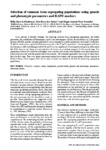Use este identificador para citar ou linkar para este item:
http://www.alice.cnptia.embrapa.br/alice/handle/doc/508871Registro completo de metadados
| Campo DC | Valor | Idioma |
|---|---|---|
| dc.contributor.author | MENDONÇA, H. A. | pt_BR |
| dc.contributor.author | SANTOS, J. B. dos | pt_BR |
| dc.contributor.author | RAMALHO, M. A. P. | pt_BR |
| dc.date.accessioned | 2011-04-10T11:11:11Z | pt_BR |
| dc.date.available | 2011-04-10T11:11:11Z | pt_BR |
| dc.date.created | 2008-05-05 | pt_BR |
| dc.date.issued | 2002 | pt_BR |
| dc.identifier.citation | Crop Breeding and Applied Biotechnology, Viçosa, MG, v. 2, n. 2, p. 219-226, 2002. | pt_BR |
| dc.identifier.issn | 1984-7033 (impresso) | pt_BR |
| dc.identifier.uri | http://www.alice.cnptia.embrapa.br/alice/handle/doc/508871 | pt_BR |
| dc.description | In an attempt to identify strategies for choosing common bean segregating populations, the diallel parameters, the contribution of homozygous (m+a?) and heterozygous (d) loci, the heritability (h2a), the genetic distance (RAPD), and the selection potential (Z) were estimated in a study carried out in two stages. In the first, 30 hybrid combinations (partial diallel) were assessed in the F2 and F3 generations. Increasing grain yield was due dominance effect (d) although, both GCA and SCA were significant. d varied greatly and gave an information like SCA, however h2a alone was not indicative of success in a breeding program. In the second stage, five populations with lesser d and five with higher were selected, and twenty-seven families were taken from each, which were assessed with the parents and seven controls. The estimated parameters were used to check those from the first stage. There was partial agreement among the estimates and the percentages of lines superior to Pérola cultivar, which suggests that two or more estimates are needed to identify the promising segregating populations. | pt_BR |
| dc.language.iso | eng | eng |
| dc.rights | openAccess | eng |
| dc.subject | Parâmetro fenotípico | pt_BR |
| dc.subject | Marcador RAPD | pt_BR |
| dc.subject | RAPD markers | pt_BR |
| dc.subject | Marcadores genéticos | pt_BR |
| dc.subject | Fitomejoramiento | pt_BR |
| dc.subject | Frijoles | pt_BR |
| dc.title | Selection of common bean segregating populations using genetic and phenotypic parameters and RAPD markers. | pt_BR |
| dc.type | Artigo de periódico | pt_BR |
| dc.date.updated | 2019-01-08T11:11:11Z | pt_BR |
| dc.subject.thesagro | Melhoramento genético vegetal | pt_BR |
| dc.subject.thesagro | Feijão | pt_BR |
| dc.subject.thesagro | Phaseolus vulgaris | pt_BR |
| dc.subject.thesagro | Parâmetro genético | pt_BR |
| dc.subject.thesagro | Marcador molecular | pt_BR |
| dc.subject.nalthesaurus | Plant breeding | pt_BR |
| dc.subject.nalthesaurus | Beans | pt_BR |
| dc.subject.nalthesaurus | Genetic markers | pt_BR |
| riaa.ainfo.id | 508871 | pt_BR |
| riaa.ainfo.lastupdate | 2019-01-08 -02:00:00 | pt_BR |
| dc.identifier.doi | 10.12702/1984-7033.v02n02a08 | pt_BR |
| dc.contributor.institution | HÉLIA ALVES MENDONÇA, CPAF-AC | pt_BR |
| dc.contributor.institution | JOÃO BOSCO DOS SANTOS, Universidade Federal de Lavras (UFLA), MG | eng |
| dc.contributor.institution | MAGNO ANTÔNIO PATTO RAMALHO, Universidade Federal de Lavras (UFLA), MG. | eng |
| Aparece nas coleções: | Artigo em periódico indexado (CPAF-AC)  | |
Arquivos associados a este item:
| Arquivo | Descrição | Tamanho | Formato | |
|---|---|---|---|---|
| 17388.pdf | 123.97 kB | Adobe PDF |  Visualizar/Abrir |









